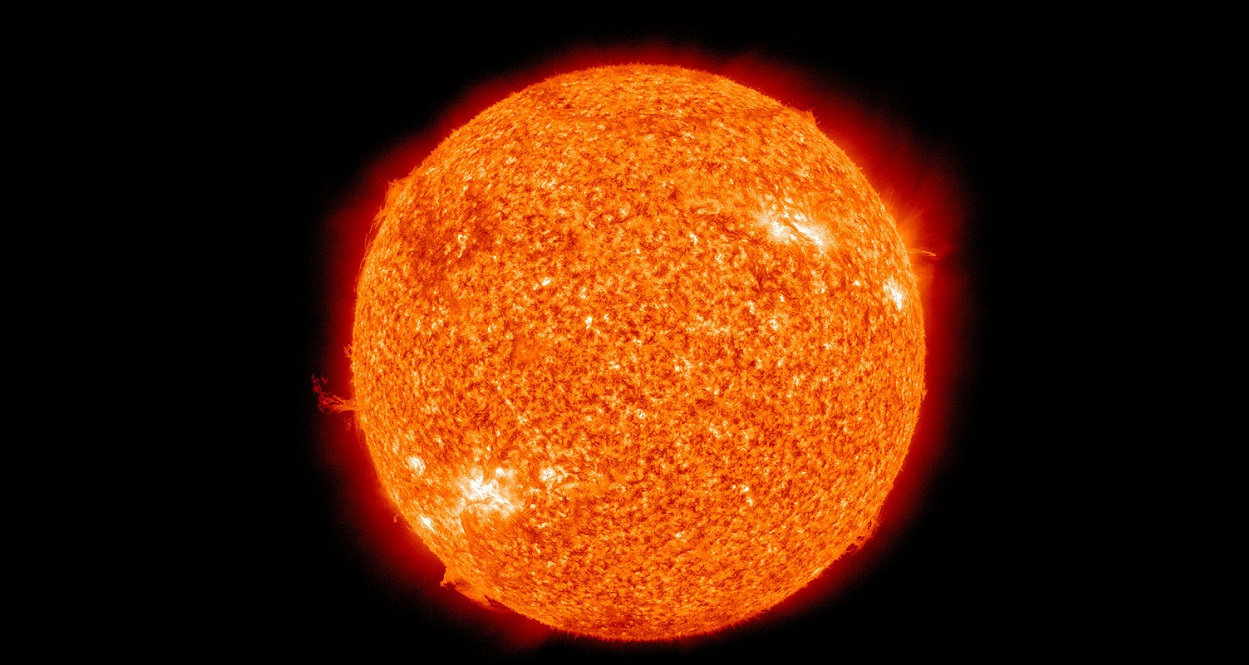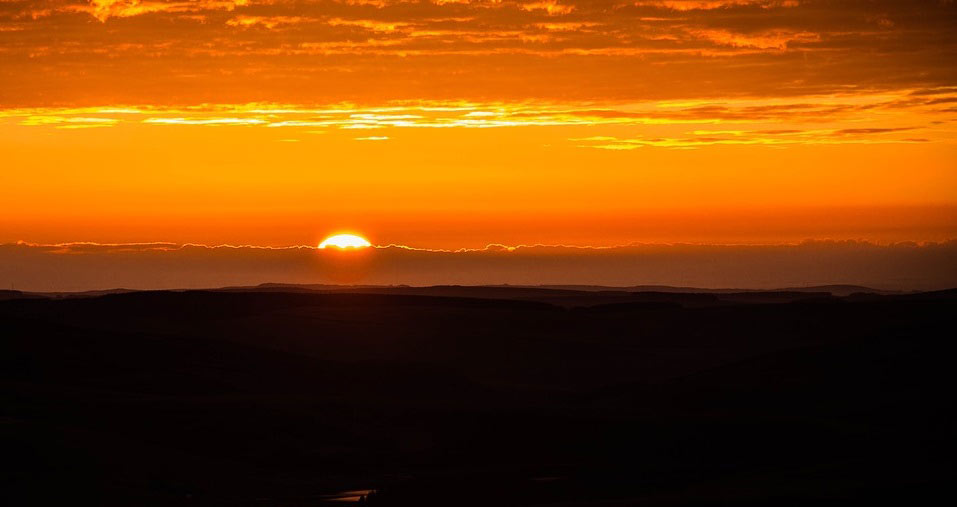The magnetosphere: under the influence of the Earth and the Sun
PDF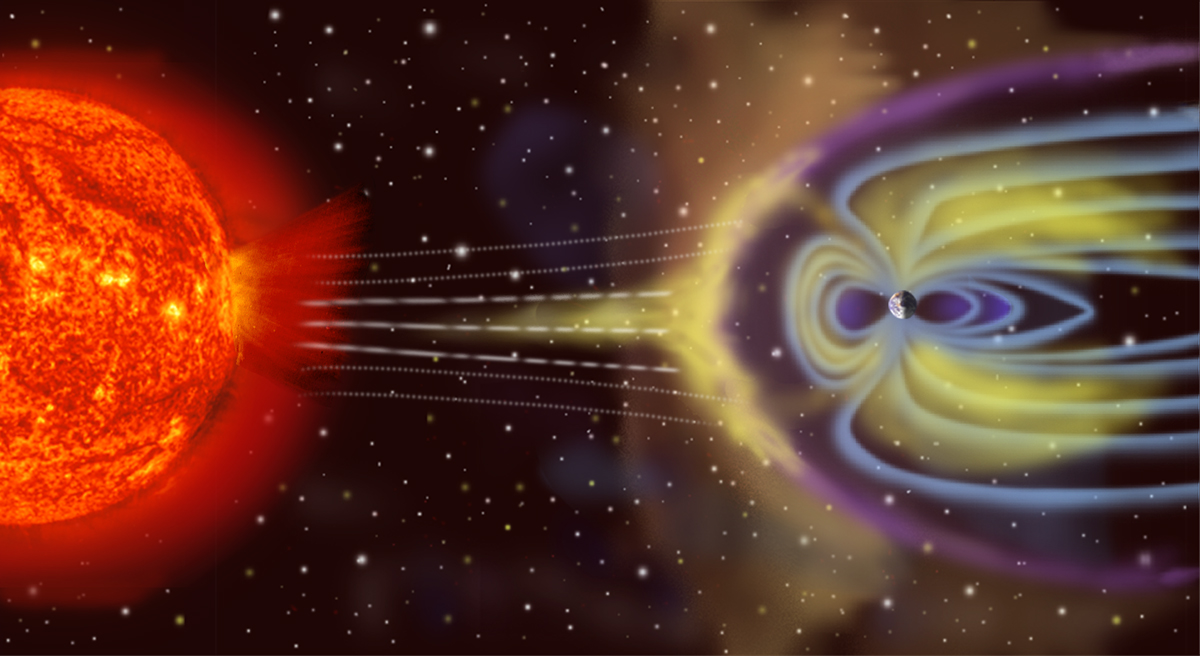
The magnetosphere is the interface between the interplanetary environment and the upper Earth’s atmosphere. It is a vast region evolving under the control of the Earth’s magnetic field. The magnetosphere is filled with a collision-free plasma, continuously out of thermodynamic equilibrium, turbulent, unstable, which undergoes almost daily global reconfigurations. The magnetosphere has only one visual manifestation, but of great aesthetic quality: the polar aurora.
1. The solar wind
Most of the Sun’s energy comes to us in the form of light, infrared, visible, ultraviolet, and in small and variable proportions, in X-rays. The Sun also sends us a tiny part of it in the form of a very diffuse wind of matter, composed of free electrons, protons, and a small proportion of helium nuclei. The components of the wind are electrically charged, it is said to be a plasma wind, or more simply a solar wind. Its density is very low, typically 10 particles per cubic centimetre, but it goes fast, between 300 and 800 kilometres per second at the level of the Earth’s orbit. That is, it travels from the Sun to the Earth’s orbit in just three days. This wind carries not only a plasma, but also the magnetic field of the solar corona. The power brought by the solar wind to the terrestrial environment has been estimated at 100 GW (gigawatts). By way of comparison, this is slightly more power than that produced in France by all power plants. This is therefore not much compared to the total solar energy received by the Earth every second (1017 watts), but more than enough to induce significant electromagnetic effects in the terrestrial environment.
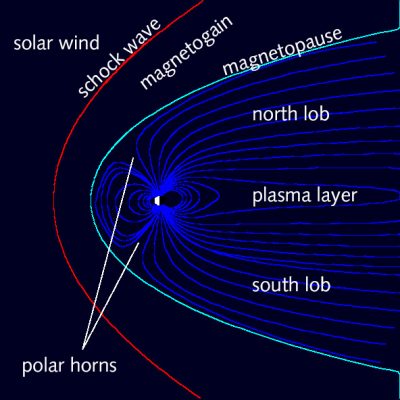
When the solar wind reaches a planet without an atmosphere like Mercury or the Moon, it hits the surface directly, contributing in particular to the very slow erosion of the soil. With planets like Venus or Mars, it is the upper atmosphere that it erodes, taking with it some of its constituents. With the Earth, it is more complicated, because it has a magnetic field, and this has an effective action on the flow of the solar wind. Conversely, the action of the solar wind modifies the magnetic field and plasmas of the Earth’s environment, creating an interface region between the interplanetary environment traversed by the solar wind and the upper Earth atmosphere. This interface, explored from 1957 with the beginning of the space age, received a name in 1959: the magnetosphere.
2. The magnetosphere
This name does not mean that this region has the shape of a sphere, but simply that it is under the control of the Earth’s magnetic field, which disappears completely into interplanetary space. Figure 1 shows a cross-section of the Earth’s magnetosphere: the Earth is the small white dot in the middle, the solar wind comes from the left, the dark blue lines are the magnetic field lines, the light blue line is the magnetopause and the red line represents the shock wave, to which we will return later.
The magnetosphere is a dynamic object, which never seems to reach a state of equilibrium. It is subject to continuous variations in the solar wind’s thrust and magnetism, as well as a series of internal processes that destabilize it by causing sudden, almost daily reconfigurations.
The Earth’s magnetosphere is the subject of two types of approaches. The first is to describe the magnetosphere (an objective achieved by scientists) and to understand the physical mechanisms that govern it. The other approach, which is complementary, aims to predict its activity in order to warn economic operators (industries, electricity networks, transport) of the fluctuations it induces on our electromagnetic environment. This article focuses on the first approach; the second is presented in the article Space Meteorology and its Consequences on Earth.
The inner boundary of the magnetosphere, closest to the Earth, is the ionosphere, which is the high-altitude atmospheric layer (from 60 km) in which, mixed with neutral gas, ionized atoms, i.e. a plasma, appear. Unlike atoms in a neutral atmosphere, these electrically charged atoms make the ionosphere a good electrical conductor. In the lower part of the ionosphere, at altitudes below 400 km, neutral gases and plasma are still relatively dense, in the sense that collisions between the particles that constitute it (atoms, molecules, ions and electrons) are frequent. Collisions generate exchanges of pulse and energy between particles, and this promotes the rapid establishment of a local thermodynamic equilibrium throughout the ionosphere. With the basic thermodynamic quantities: density, velocity, temperature, pressure, and with electrical quantities such as charge density and current, we can describe all their physics.
In the magnetosphere, the density is significantly lower, and the plasma, of solar origin, is much more energetic. This cocktail has a property that makes it special: collisions between particles are extremely rare. A particle typically has to travel a hundred thousand kilometres before colliding with another particle. In scientific terms, the average free ride is about 100,000 kilometres. Since this is also the characteristic dimension of the magnetosphere, it is deduced that the plasma of the magnetosphere is made up of particles without collisions with each other. They say it’s a collision-free plasma.
This variety of plasma does not occur naturally on Earth. Collision-free plasmas are not in local thermodynamic equilibrium (link to article Thermodynamics). For example, when cold plasma of ionospheric origin is mixed with hot plasma of solar origin, we do not obtain a warm plasma, whose particles would have a thermal agitation rate that would be a kind of average between the thermal agitation rates of the ionosphere and the solar wind. On the contrary, there are still particles that move little (the cold ones) and others that move in all directions at high speeds (the hot ones), all together, in the same places. Mathematically, a temperature can always be defined, but this notion is very insufficient to give a precise idea of the state of magnetospheric plasma. This is extremely unintuitive and confusing for physicists accustomed to the fluids encountered in our daily environment and in laboratories.
The absence of collisions also makes magnetospheric plasma very special, without viscosity, thus becoming very easily turbulent. To figure out the viscosity, you can take liquid honey and lower it into a pipe. The flow will be very slow, and slowed down by the honey on the edge, which is almost immobilized on the walls. By doing the same experiment with water, whose viscosity is much lower than that of honey, the flow will be faster, but still not uniform. The water in the middle will flow much faster than the water near the wall (for water, we can see things better by observing the flow of rivers). It is also an effect of viscosity. With its lower viscosity, water has much more turbulent movements than honey. With the collision-free plasma of the magnetosphere, virtually viscosity-free, the turbulent effects are further amplified. This still prevents it from reaching the slightest state of equilibrium, even locally and briefly.
Finally, like any plasma, the plasma of the magnetosphere is formed of electric particles, its movement is controlled by the electromagnetic field, especially by the magnetic field of Earth origin. Conversely, since its charged particles are in motion, they are also sources of electromagnetic fields; this plasma therefore modifies the Earth’s electrical and magnetic environment.
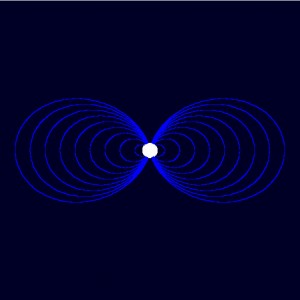
If the magnetosphere and the solar wind did not exist, the magnetic field around the Earth would be a dipole magnetic field, like the one represented in Figure 2 by its field lines. It would extend infinitely in space, losing its intensity as it moves further and further away. Because of the solar wind, the magnetic field lines look as shown in Figure 1, and this representation shows several things: the magnetosphere has a very elongated shape. It extends 60,000 kilometres from Earth on the sun side (the day side), but hundreds of thousands of kilometres away on the opposite side (the night side). Then, with the topography of the field lines, several regions are distinguished, whose spatial probes have revealed distinct properties.
3. The regions of the magnetosphere
The outermost region of the magnetosphere is a shock wave through which the solar wind passes from a supersonic speed to a subsonic speed. Behind the shock wave is magnetogaine, a very turbulent region of plasma, and “noisy” because it is traversed by a wide variety of very low frequency electromagnetic waves. (However, it is not a noise audible to a human ear.) Then comes the actual limit of the magnetosphere: the magnetopause. In the magnetogaine, it is still the matter from the solar wind that flows, and the magnetic field is of solar origin. Behind the magnetopause, we find a plasma partly of solar origin, partly of terrestrial origin, with very different characteristics. Only a small part of the solar wind manages to enter the magnetosphere through the magnetopause. On average, the density of matter in the magnetosphere is lower than in the solar wind. It’s like a kind of bubble, with a complicated shape. The magnetic field of the magnetosphere is of terrestrial origin. By following the magnetic field lines, at least in one direction, we always end up reaching the Earth’s ionosphere. The most complex region of the magnetosphere is on the night side. There are the two lobes shown in Figure 1, to the north and south, almost devoid of plasma.
4. The activity of the magnetosphere
Between the two lobes, the region called the current layer is characterized by a weaker magnetic field, which changes direction. This is where most of the magnetosphere’s plasma accumulates. As plasma from the solar wind reaches the magnetosphere, the current layer fills up. This region is continuously traversed by an electric current that runs from east to west (perpendicular to the plane in Figure 1). It is also the most unstable region: when the plasma accumulates a little too much, the current layer becomes thinner (paradoxically), and the current intensifies. Then, the whole thing finally cracked.
How does the current layer crack? The researchers have discovered several mechanisms called “magnetic reconnection”, “interchange instability”, but this remains a very active and still controversial subject of study.
What’s going on? The current layer is emptied in a few tens of minutes. Some of the plasma goes to space, some to Earth. These reconfiguration episodes of the current layer where it suddenly empties are called magnetospheric sub-storms. Typically, one or more sub-storms, or pseudo-triggers, occur each day with varying intensities, releasing more or less plasma with more or less energy. The visible and spectacular manifestations of these sub-storms are the polar auroras, which we will discuss in section 6.
5. The acceleration of plasma in the magnetosphere
When we study the magnetosphere, we measure the energy of particles in electron volts (eV, read Energy). The particles of the solar wind enter the magnetosphere with a typical energy of 100 eV, i.e. as if they had been accelerated by a 100 volt drop in electrical potential. Particles in the ionosphere have an energy of 0.1 eV, but those escaping into the magnetosphere often gain an energy of a few eV. In the tail of the magnetosphere, particles of various energies, from 10 eV to 50 keV (kilo-eV), are found. Commonly, their energy is in the order of 100 eV. During sub-storms, they earn a few hundred eV. These acceleration mechanisms are diverse, associated with waves, changes in the magnetic field and the accompanying electric fields.
6. The polar auroras
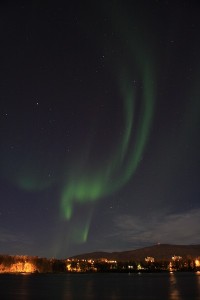
The brightest auroras are all associated with the reconfiguration of the magnetosphere’s plasma layer, so they all occur during a substorm. Shortly before these episodes, we can also observe auroras, but they are less bright and very static. They often correspond to the end of the current layer filling period, when “leaks” begin to occur.
The solar wind, like any wind, also experiences storms. Several dozen of them occur each year, of varying intensities. These storms can affect the density and speed of the solar wind, but also the intensity and variations in the orientation of its magnetic field. And sometimes these storms compress the Earth’s magnetosphere. Once compressed, the magnetosphere enters a relaxation phase, during two or three days, during which its activity is stronger than usual. Substorms are stronger and more frequent, and auroras can be seen in places where it is uncommon to see them (in France, for example). These episodes are called magnetic storms. It is the purpose of space weather (see Space Weather and its Consequences on Earth) to predict magnetic storms that could have a significant influence on human activity.
The Encyclopedia of the Environment by the Association des Encyclopédies de l'Environnement et de l'Énergie (www.a3e.fr), contractually linked to the University of Grenoble Alpes and Grenoble INP, and sponsored by the French Academy of Sciences.
To cite this article: MOTTEZ Fabrice (January 5, 2025), The magnetosphere: under the influence of the Earth and the Sun, Encyclopedia of the Environment, Accessed March 30, 2025 [online ISSN 2555-0950] url : https://www.encyclopedie-environnement.org/en/air-en/magnetosphere-under-influence-earth-and-sun-2/.
The articles in the Encyclopedia of the Environment are made available under the terms of the Creative Commons BY-NC-SA license, which authorizes reproduction subject to: citing the source, not making commercial use of them, sharing identical initial conditions, reproducing at each reuse or distribution the mention of this Creative Commons BY-NC-SA license.





